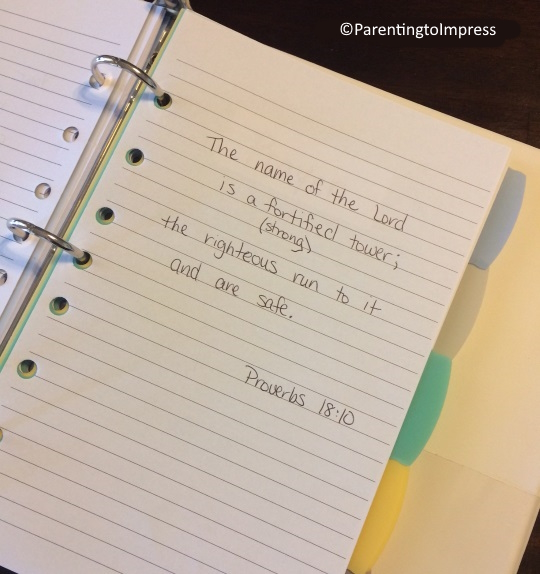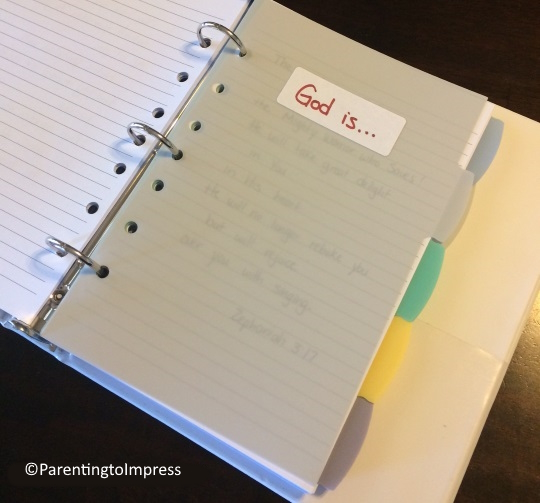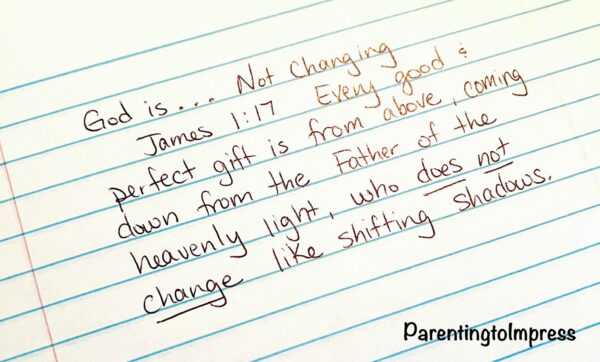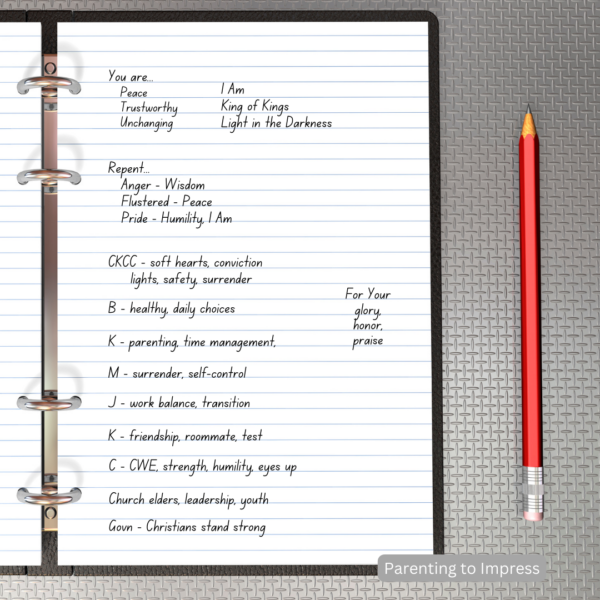If I were asked what has had the biggest impact on my spiritual life, I would say, without hesitation, my prayer journal. However, it’s important to know that my experience with prayer journals hasn’t always been great.
Each time I purchased or received a prayer journal, excitement overflowed as I imagined that this journal would suddenly transform my prayer life. Yet, after a couple of weeks, the newness wore off, and I found myself back to feeling frustrated and desiring more. I discovered that the pre-bound book format felt restraining and was hard to use with my Type A personality.
Then, God led me to the idea of using a 3-ring binder instead of a pre-bound book. Twelve years and many revisions later, my prayer journal has truly transformed my daily time with God.

MY PRAYER JOURNAL SUPPLIES
5.5×8.5″ Binder
I prefer the smaller size of 3-ring binder because it’s easy to hold in my lap and matches the size of my Bible. With the clear cover pocket, I can place a note card, memory verse, or picture to personalize it. For those who are creative, you can even design a pretty slip-in cover.
5.5×8.5″ Filler Paper
The paper is the only item that will need replenishing. The filler paper is used for taking notes from your reading, prayer, and keeping a list of God’s blessings. When the binder becomes full, I simply remove the filled pages and add blank sheets.
5.5×8.5″ Dividers
While not required, the dividers make it simple to move between the sections.
Your Favorite Pen
I find that I write more when I have a pen that feels good in my hand. It’s like the concept of wearing fun workout clothes when you’re running—it just adds to the experience. So, don’t hesitate to splurge and order a fun gel pen.
ASSEMBLING MY PRAYER JOURNAL
There are many ways to develop a prayer journal, but this is the method I use and find effective. I encourage you to start with these ideas and then tweak them as you find what works best for you.
To begin, place four dividers in the binder, adding several filler pages in between each divider.
SETTING UP THE SECTIONS
My Prayer Notebook consists of four sections based on the acronym “DRAW Deep.” This acronym reflects my desire to draw deep from God’s well of wisdom and comfort.
- Devotion – Who God is.
- Reflection – What God is teaching me.
- Acknowledge – How God is blessing me.
- Will of God – Praying God’s will over my requests.

WHAT TO JOURNAL
DEVOTION: WHO GOD IS
While not used every day, this section contains verses and quotes that remind me who God is. As you come across verses (from your quiet time, church, etc.) pertaining to God’s character, write them in this section. Sometimes I include the lyrics to a worship song, a quote from a book, or key point from a message at church or a podcast.
For each verse or thought written down, I add a heading that finishes the statement “God is…”. For example, if the verse is about God’s power, I write “…Powerful” and then the verse and reference. On days when I need encouragement about God’s power over the universe, I can immediately find these verses by their headings.
Below is an example from my journal.

REFLECTION – WHAT GOD WANTS ME TO LEARN
In this section I take notes about what I read during my quiet time or points I want to remember from the sermon.
When studying a few verses at a time, I have found greatest comprehension when I “draw” the verses. This is what I do:
- Read the Scripture (out loud if possible) while exaggerating the punctuation.
- Write the key verse using drawings and pictures to help me understand the key words in the verse.
Drawing the words has provided so much depth to the Scriptures and has forces me to look for the keywords and think about their meaning.
Here is an example.

Over time, I’ve developed drawings for the most common key words. For example, I draw a cross over the name “Jesus” and a triangle over “God.” This consistency helps with continuity between verses. As you engage in this exercise, you’ll naturally develop your own drawings.
There is a right or wrong way to do this and being an artist is not required. The key to this process is that the drawings that you choose make sense to you.
In the Reflection section of my journal, I also write down what God teaches me in my Bible reading – a key thought or question. This section could be used to take notes from a sermon at church. However, I don’t use this section if I am using a Bible Study guide.
ACKNOWLEDGE – WHAT GOD HAS DONE.
A sweet friend suggested that I add this section to my prayer journal, and she was absolutely right! No matter how big or small, each day I make a note of a blessing that God sent my way. I started with #1 and am now on #2231. It’s important to date the blessings as you’ll enjoy looking back at all God has done in your life. This activity helps me begin my prayer time with gratitude, and it provides a reminder of God’s faithfulness.
WILL OF GOD – PRAYING GOD’S WILL OVER MY REQUESTS.
Each day’s prayer is its own blank sheet of paper. I start by adding the date at the top of the page. Then, I write key words of what I am praying about or use people’s initials to keep track of my thoughts. This practice has dramatically helped me stay focused during my prayer time.
I use the follow format to guide my prayer time.
- Praise – Who God is, What God does
- Repent – What God showed me in my Reflection time
- Ask – Family, Friends, Church, Gov, Those on My Heart for Heaven
- Yield – Not my will but Yours, Lord
Here is an example.

I encourage you to go back and write the answers and dates to prayers.
USING A PRAYER JOURNAL IN QUIET TIME
Each morning, I begin with a prayer, asking the Holy Spirit to open my heart to what He desires to teach me and guide me to do. I ask the Lord to provide clear thoughts and give me an open heart.
Then, I dive into my reading. This could be a set of Bible verses or a devotional book that is Scripture-based. During this time, I take notes or “draw” out a key verse in the second section titled “Reflection.” If I’m using a Bible study guide with space for notes, I write directly in the book instead of my prayer journal.
If there’s a verse or point that helps me better understand who God is or what He wants to do in my life, I refer back to the “Devotion” section of my journal.
Next, I turn to the “Acknowledge” section of my journal and reflect on how I saw God work in my life the day before. Sometimes it’s in significant events, and other times it’s in the smallest details where I see His fingerprints.
Finally, I conclude with prayer, using the guide above.
IS A PRAYER JOURNAL FOR YOU?
I pray that what’s been shared is just what you need—a guide to kickstart your spiritual journey and create a sacred space for your quiet time. Remember, there’s nothing legalistic about the prayer journal. Just come each day with an open heart, ready to listen. I assure you, God will meet you there.
I invite you to watch this video to discover mistakes I’ve made, simple changes I’ve done, and tips that have transformed my Quiet Time – all ideas YOU can immediately implement into your own life.



